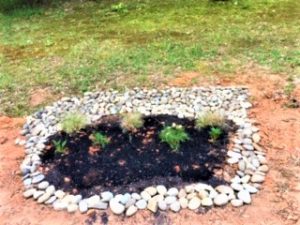Home remedy for stormwater runoff
Her backyard now rocks a rain garden instead of a mud puddle.
By Maris Lawyer (Posted June 4, 2019):

With soil, a few plants, and a little sweat, your backyard pooling problems can be solved. Throw in some stones for added filtration and aesthetic effect.
For homeowners with erosion or flooding problems on their property, a rain garden can be an ideal solution. If the concept of a rain garden is new to you, be sure to read my previous blog post on what a rain garden is and how it works. This time around, I want to walk you through the steps of building a rain garden, and share the early results of the rain garden I made at home.
Building a rain garden is simple: First identify areas near your home that tend to flood (such as a concavity in the landscape), or zones that experience additional runoff (near gutters or driveways). For my backyard project, I identified a small basin made of packed clay, which pools with water any time it rains.
A rain garden can be virtually any size, but it’s advisable to keep the garden at least 10 feet away from the house to encourage water not to “sit” near your home’s foundation. Once you’ve identified the location for your rain garden, a little landscaping is required. You will need to shape the surface of the garden to create a slight berm along at least one side so that water will filter down to the base. A rain garden is NOT meant to be a pond — but it does create a natural topography that causes water to settle and then return to a groundwater reserve.
After plotting out the size and shape of your rain garden, some sweat is required to dig 8 inches to 1 foot deep into the soil. Adding horticultural grit or fine gravel into the soil aids drainage and will help any pooling water filter down to a groundwater reserve. I elected to also incorporate a few bags of organic topsoil to improve soil texture and nutrients. After the soil is prepared, all that is left is to select native flowers and grasses to plant, which will help absorb the water as well as create a natural habitat for wildlife.
My plant selection began with frosted explosion switch grass, a native North American plant that does well in our tricky Carolina red clay. I also chose yarrow, another native plant that produces broad flower heads that attract native pollinators. I added in black-eyed Susans and Mexican primroses — not regional flowers, but they do well in our climate and self-seed prolifically. Lastly, I sowed a mixture of southeastern wildflower seeds in the front of the bed. The seeds (with some luck) will germinate in a few weeks and explode with color.
Lining the rain garden with river rock (which I had on hand from a previous gardening project) adds to the aesthetic of the garden while also helping excess water filter into the bed. As we head into summer and inevitable summer thunderstorms, I hope to see my rain garden prove its mettle while serving as a scenic feature in our backyard.
Maybe you have stormwater issues on a larger scale than home erosion problems. If so, SynTerra has stormwater management experts who can design an effective and environmentally conscious solution for you.




